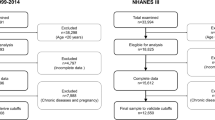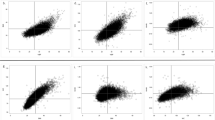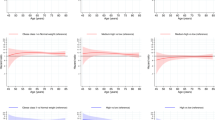Abstract
Objectives
Body composition changes that occur with aging pose unique health risks to older adults. The current World Health Organization (WHO) body mass index (BMI) cut-points may not accurately reflect health risks in older adults (65+). Prior findings suggest those classified as overweight may be conferred survival advantages. This study aims to define age-specific BMI cut-points for adults (45–64, 65–74, and 75–85 years) associated with cardiometabolic outcomes, and compare the performance of these thresholds to the WHO BMI thresholds using cardiometabolic conditions and frailty as outcomes.
Methods
Using baseline data from the comprehensive cohort of the Canadian Longitudinal Study on Aging (N = 30,097), a classification and regression tree cross-sectional analysis was conducted to derive age-specific BMI cut-points based on cardiometabolic health risk. The area under the receiver operating curve (AUC), sensitivity, and specificity were estimated. Agreement with waist circumference was conducted.
Results
For older adults (65–74 and 75+ years old), the BMI threshold for identifying overweight increased to 26.9 and 26.6, respectively, from the WHO definition of 25.0 kg/m2. For obesity, the thresholds were revised to 29.0 and 30.9, respectively, from 30.0. The largest improvements to AUC occurred in older adults (65+). Across all age-sex stratifications, the new overweight threshold demonstrated lower sensitivity and higher specificity compared to the traditional threshold. Age-specific BMI thresholds demonstrated higher agreement with waist circumference for some age-sex stratifications and poor performance with hearing.
Conclusions
Age-appropriate BMI thresholds for older adults may improve classification by health risk compared to standard WHO cut-points. A higher overweight threshold but lower obesity cut-points may be best suited to this demographic.
This is a preview of subscription content, access via your institution
Access options
Subscribe to this journal
Receive 12 print issues and online access
$259.00 per year
only $21.58 per issue
Buy this article
- Purchase on Springer Link
- Instant access to full article PDF
Prices may be subject to local taxes which are calculated during checkout
Similar content being viewed by others
References
Statistics Canada. Health fact sheets: overweight and obese adults, 2018. 2019;82:1–8. https://www150.statcan.gc.ca/n1/pub/82-625-x/2019001/article/00005-eng.htm.
World Health Organization. Physical status: the use and interpretation of anthropometry: report of a WHO Expert Committee; WHO; Switzerland, 1995. p. 854.
Nuttall FQ. Body mass index. Nutr Today. 2015;50:117–28. http://content.wkhealth.com/linkback/openurl?sid=WKPTLP:landingpage&an=00017285-201505000-00005.
Statistics Canada. ‘Canada’s population estimates: Age and sex’, Statistics Canada, 2015, http://www.statcan.gc.ca/daily-quotidien/150929/dq150929b-eng.pdf, (accessed 26 January 2022).
Bohnert, N, Chagnon, J, Coulombe, S, Dion, P Martel, L. Population projections for Canada (2013 to 2063), provinces and territories (2013 to 2038): technical report on methodology and assumptions. Statistics Canada. 2015. Catalogue no. 91-520-X.
Kuk JL, Saunders TJ, Davidson LE, Ross R. Age-related changes in total and regional fat distribution. Ageing Res Rev. 2009;8:339–48.
Zamboni M, Armellini F, Harris T, Turcato E, Micciolo R, Bergamo-Andreis IA, et al. Effects of age on body fat distribution risk factors in women. Am J Clin Nutr. 1997;66:111–5.
Gallagher D, Ruts E, Visser M, Heshka S, Baumgartner RN, Wang J, et al. Weight stability masks sarcopenia in elderly men and women. Am J Physiol Metab. 2000;279:E366–75.
Shimokata H, Tobin JD, Muller DC, Elahi D, Coon PJ, Andres R. Studies in the distribution of body fat: I. Effects of age, sex, and obesity. J Gerontol. 2012;44:M66–73.
Teh BH, Pan WH, Chen CJ. The reallocation of body fat toward the abdomen persists to very old age, while body mass index declines after middle age in Chinese. Int J Obes Relat Metab Disord. 1996;20:683–7. http://www.ncbi.nlm.nih.gov/entrez/query.fcgi?cmd=Retrieve&db=PubMed&dopt=Citation&list_uids=8817363.
Ito H, Ohshima A, Ohto N, Ogasawara M, Tsuzuki M, Takao K, et al. Relation between body composition and age in healthy Japanese subjects. Eur J Clin Nutr. 2001;55:462–70. http://ovidsp.ovid.com/ovidweb.cgi?T=JS&PAGE=reference&D=emed5&NEWS=N&AN=2001209050.
Shimokata H, Andres R, Coon PJ, Elahi D, Muller DC, Tobin JD. Studies in the distribution of body fat. II. Longitudinal effects of change in weight. Int J Obes. 1989;13:455–64. http://ovidsp.ovid.com/ovidweb.cgi?T=JS&PAGE=reference&D=emed2&NEWS=N&AN=2676875.
Noppa H, Andersson M, Bengtsson C, Bruce A, Isaksson B. Longitudinal studies of anthropometric data and body composition The population study of women in Göteborg, Sweden. Am J Clin Nutr. 2019;33:1–6.
Carmelli D, McElroy MR, Rosenman RH. Longitudinal changes in fat distribution in the Western Collaborative Group Study: a 23-year follow-up. Int J Obes. 1991;15:67–74. http://www.ncbi.nlm.nih.gov/pubmed/2010260.
Zamboni M, Zoico E, Scartezzini T, Mazzali G, Tosoni P, Zivelonghi A, et al. Body composition changes in stable-weight elderly subjects: the effect of sex. Aging Clin Exp Res. 2003;15:321–7. http://www.ncbi.nlm.nih.gov/pubmed/14661824.
Hughes VA, Roubenoff R, Wood M, Frontera WR, Evans WJ, Fiatarone, et al. Anthropometric assessment of 10-y changes in body composition in the elderly. Am J Clin Nutr 2004;80:475–82. http://www.ncbi.nlm.nih.gov/pubmed/15277173.
Beaufrère B, Morio B. Fat and protein redistribution with aging: metabolic considerations. Eur J Clin Nutr. 2000;54:S48–53. July 2000.
Sorkin JD, Muller DC, Andres R. Longitudinal change in the heights of men and women: Consequential effects on body mass index. Epidemiol Rev. 1999;21:247–60.
Boldt A. The disadvantages of BMI. Livestrong. 2019. https://www.livestrong.com/article/32791-disadvantages-bmi/.
Harvard TH. Chan School of Public Health. Why use BMI? [Internet]. Obesity Prevention Source. 2019. https://www.hsph.harvard.edu/obesity-prevention-source/obesity-definition/obesity-definition-full-story/#references.
Gallagher D, Visser M, Sepulveda D, Pierson R, Harris T, Heymsfield SB. How useful is body mass index for comparison of body fatness across age, sex, and ethnic groups? Am J Epidemiol. 1996;143:228–39.
WHO Expert Consultation. Waist circumference and waist-hip ratio report of a WHO expert consultation. World Health Organization; Geneva, Switzerland, 2008;8–11.
Kim SH, Després JP, Koh KK. Obesity and cardiovascular disease: friend or foe? Eur Heart J. 2016;37:3560–8.
Troiano RP, Frongillo EA, Jr. Sobal J, Levitsky DA. The relationship between body weight and mortality: a quantitative analysis of combined information from existing studies. Int J Obes Relat Metab Disord. 1996;20:63–75.
Pischon T, Boeing H, Hoffmann K, Bergmann M, Schulze MB, Overvad K, et al. General and abdominal adiposity and risk of death in Europe. N Engl J Med. 2008;359:2105–20. http://www.nejm.org/doi/abs/10.1056/NEJMoa0801891.
Adams KF, Schatzkin A, Harris TB, Kipnis V, Mouw T, Ballard-Barbash R, et al. Overweight, obesity, and mortality in a large prospective cohort of persons 50 to 71 years old. N Engl J Med. 2006;355:763–78.
Zhu S, Heo M, Plankey M, Faith MS, Allison DB. Associations of body mass index and Anthropometric indicators of fat mass and fat free mass with all-cause mortality among women in the First and Second National Health and Nutrition Examination Surveys follow-up studies. Ann Epidemiol. 2003;13:286–93.
Batsis JA, Mackenzie TA, Bartels SJ, Sahakyan KR, Somers VK, Lopez-Jimenez F. Diagnostic accuracy of body mass index to identify obesity in older adults: NHANES 1999–2004. Int J Obes. 2016;40:761–7.
Sergi G, Perissinotto E, Pisent C, Buja A, Maggi S, Coin A, et al. An adequate threshold for body mass index to detect underweight condition in elderly persons: the Italian Longitudinal Study on Aging (ILSA). J Gerontol Ser A Biol Sci Med Sci. 2005;60:866–71.
Dobbelsteyn CJ, Joffres MR, MacLean DR, Flowerdew G, Balram C, Blair L, et al. A comparative evaluation of waist circumference, waist-to-hip ratio and body mass index as indicators of cardiovascular risk factors. The Canadian heart health surveys. Int J Obes. 2001;25:652–61.
Katzmarzyk PT, Bray GA, Greenway FL, Johnson WD, Newton RL Jr, Ravussin E, et al. Ethnic-specific BMI and waist circumference thresholds. Obesity. 2011;19:1163–70. https://doi.org/10.1038/oby.2010.264/nature06264.
Hubbard RE, Lang IA, Llewellyn DJ, Rockwood K. Frailty, body mass index, and abdominal obesity in older people. J. Gerontol Ser A Biol Sci Med Sci. 2010;65 A:377–81.
Raina P, Wolfson C, Kirkland S, Griffith LE, Balion C, Cossette B, et al. Cohort profile: the Canadian Longitudinal Study on Aging (CLSA). Int J Epidemiol. 2019;48:1752–1753J.
Norberg SJ, Toohey AM, Jones S, McDonough R, Hogan DB. Examining the municipal-level representativeness of the Canadian longitudinal study on aging (CLSA) cohort: an analysis using Calgary participant baseline data. Health Promot Chronic Dis Prev Canada. 2021;41:48–56.
Raina PS, Wolfson C, Kirkland SA, Griffith LE, Oremus M, Patterson C, et al. The Canadian longitudinal study on aging (CLSA). Can J Aging. 2009;28:221–9.
Canadian Longitudinal Study on Aging. CLSA standard operating procedure (SOP): standing height and weight measurement. 2016. https://www.clsa-elcv.ca/doc/1112.
Tessier AJ, Wing SS, Rahme E, Morais JA, Chevalier S. Physical function-derived cut-points for the diagnosis of sarcopenia and dynapenia from the Canadian longitudinal study on aging. J Cachexia Sarcopenia Muscle. 2019;10:985–99.
Centers for Disease Control and Prevention. The health effects of overweight & obesity. US Department of Health & Human Services; 2015.
Pi-Sunyer X. The medical risks of obesity. Postgrad Med. 2009;121:21–33.
N.O.E.I.E. Panel. Treatment guidelines. Clinical guidelines on the identification, evaluation, and treatment of overweight and obesity in adults: the evidence report; National Heart, Lung, and Blood Institute, Bethesda, MD, 1998.
Canadian Longitudinal Study on Aging. 'Return of a derived variable to the CLSA: sample document for users: Frailty Index', Canadian Longitudinal Study on Aging, 2019, clsa-elcv.ca/doc/1112, (accessed 7 June 2019).
Kanters DM, Griffith LE, Hogan DB, Richardson J, Patterson C, Raina P. Assessing the measurement properties of a Frailty Index across the age spectrum in the Canadian Longitudinal Study on Aging. J Epidemiol Community Health. 2017;71:794–9.
Rockwood K, Mitnitski A. Unconventional views of frailty frailty in relation to the accumulation of deficits. J Gerontol A Biol Sci Med Sci. 2007;62:722–7.
Searle SD, Mitnitski A, Gahbauer EA, Gill TM, Rockwood K. A standard procedure for creating a frailty index. BMC Geriatr. 2008;8:1–10.
Breiman L, Friedman J, Stone CJ, Olshen RA. Classification and regression trees. Taylor & Francis; Boca Raton, FL, 1984. p. 1–368.
IBM Knowledge Center. CART algorithms. 2013. https://www.ibm.com/support/knowledgecenter/en/SSLVMB_22.0.0/com.ibm.spss.statistics.algorithms/alg_tree-cart.htm.
IBM. IBM SPSS Statistics for Windows, version 20.0. New York: IBM; 2011.
Bennett DA. How can I deal with missing data in my study? Aust N Z J Public Health. 2001;25:464–9. https://onlinelibrary.wiley.com/doi/pdf/10.1111/j.1467-842X.2001.tb00294.x.
Neovius M, Linné Y, Rossner S. BMI, waist-circumference and waist-hip-ratio as diagnostic tests for fatness in adolescents. Int J Obes. 2005;29:163–9.
Flegal KM, Carroll MD, Kuczmarski RJ, Johnson CL. Overweight and obesity in the United States: Prevalence and trends, 1960-1994. Int J Obes. 1998;22:39–47.
Banack HR, Wactawski-Wende J, Hovey KM, Stokes A. Is BMI a valid measure of obesity in postmenopausal women? Menopause. 2018;25:307–13.
Evans EM, Rowe DA, Racette SB, Ross KM, McAuley E. Is the current BMI obesity classification appropriate for black and white postmenopausal women? Int J Obes. 2006;30:837–43.
Blew RM, Ferreira DL, Harris MM, Lohman TG, Sardinha LB, Teixeira PJ, et al. Assessing the validity of body mass index standards in early postmenopausal women. Obes Res. 2002;10:799–808.
Bowman K, Delgado J, Henley WE, Masoli JA, Kos K, Brayne C, et al. Obesity in older people with and without conditions associated with weight loss: follow-up of 955,000 primary care patients. J Gerontol Ser A Biol Sci Med Sci. 2016;72:203–9.
Hsu C-C, Liu T-T, Chang Y-H, Tsai Y-F, Wahlqvist ML, Chang I-S, et al. Cardiometabolic disorder reduces survival prospects more than suboptimal body mass index irrespective of age or gender: a longitudinal study of 377,929 adults in Taiwan. BMC Public Health. 2018;18:1–11.
Hu HY, Lee YL, Lin SY, Chou YC, Chung D, Huang N, et al. Association between tooth loss, body mass index, and all-cause mortality among elderly patients in Taiwan. Medicine. 2015;94:e1543.
Hirani V, Naganathan V, Blyth F, Le Couteur DG, Gnjidic D, Stanaway FF, et al. Multiple, but not traditional risk factors predict mortality in older people: the concord health and ageing in men project. Age. 2014;36:1–15.
Chung WS, Ho FM, Cheng NC, Lee MC, Yeh CJ. BMI and all-cause mortality among middle-aged and older adults in Taiwan: A population-based cohort study. Public Health Nutr. 2015;18:1839–46.
LaMorte WW. Evaluating screening tests. In: The role of probability. Boston University School of Public Health; Boston, MA, 2016.
Department of Health New York State. Disease Screening - Statistics Teaching Tools. Department of Health; 1999. https://www.health.ny.gov/diseases/chronic/discreen.htm.
Borkan GA, Hults DE, Gerzof SG, Robbins AH, Silbert CK. Age changes in body composition revealed by computed tomography. J Gerontol. 1983;38:673–7.
Lavie CJ, Milani RV, Ventura HO. Obesity and cardiovascular disease. risk factor, paradox, and impact of weight loss. J Am Coll Cardiol. 2009;53:1925–32. https://doi.org/10.1016/j.jacc.2008.12.068.
Poirier P, Giles TD, Bray GA, Hong Y, Stern JS, Pi-Sunyer FX, et al. Obesity and cardiovascular disease: Pathophysiology, evaluation, and effect of weight loss: an update of the 1997 American Heart Association Scientific Statement on obesity and heart disease from the Obesity Committee of the Council on Nutrition, Physical. Circulation. 2006;113:898–918.
Horwich TB, Fonarow GC, Hamilton MA, MacLellan WR, Woo MA, Tillisch JH. The relationship between obesity and mortality in patients with heart failure. J Am Coll Cardiol. 2001;38:789–95. https://doi.org/10.1016/S0735-1097(01)01448-6.
Locher JL, Roth DL, Ritchie CS, Cox K, Sawyer P, Bodner EV, et al. Body mass index, weight loss, and mortality in community-dwelling older adults. J Gerontol Ser A Biol Sci Med Sci. 2007;62:1389–92.
Cox ZL, Lai P, Lewis CM, Lenihan DJ. Limits of the obesity paradox: obese patients with heart failure are at higher risk of hospitalization. J Card Fail. 2017;23:S110–1. https://doi.org/10.1016/j.cardfail.2017.07.324.
Canada S. Census in brief: a portrait of the population age 85 and older in 2016 in Canada. 2016;98. http://www12.statcan.gc.ca/census-recensement/2016/as-sa/98-200-x/2016004/98-200-x2016004-eng.cfm.
Wharton S, Lau DCW, Vallis M, Sharma AM, Biertho L, Campbell-Scherer D, et al. Obesity in adults: a clinical practice guideline. CMAJ. 2020;192:E875–91.
Acknowledgements
This research was made possible using the data/biospecimens collected by the Canadian Longitudinal Study on Aging (CLSA). Funding for the Canadian Longitudinal Study on Aging (CLSA) is provided by the Government of Canada through the Canadian Institutes of Health Research (CIHR) under grant reference: LSA 94473 and the Canada Foundation for Innovation. This research has been conducted using the CLSA dataset Baseline Comprehensive dataset version 3.0, under Application Number 160313. The CLSA is led by Drs. Parminder Raina, Christina Wolfson and Susan Kirkland. PR holds a Tier 1 Canada Research Chair in Geroscience and the Raymond and Margaret Labarge Chair in Research and Knowledge Application for Optimal Aging. Data are available from the Canadian Longitudinal Study on Aging (www.clsa-elcv.ca) for researchers who meet the criteria for access to de-identified CLSA data. Lauren Griffith is supported by the McLaughlin Foundation Professorship in Population and Public Health.
Author information
Authors and Affiliations
Contributions
AJ: conceptualized the research question, conducted analysis, and drafted the manuscript. JM: statistical analysis and writing. LA: analysis, writing, and interpretation. AM: contributed to analysis and writing. HS: statistical analysis and writing. LG: interpretation and writing. AG: design and writing. PR: design, data collection, analysis, interpretation, and writing.
Corresponding author
Ethics declarations
Competing interests
The authors declare no competing interests.
Additional information
Publisher’s note Springer Nature remains neutral with regard to jurisdictional claims in published maps and institutional affiliations.
Supplementary information
Rights and permissions
About this article
Cite this article
Javed, A.A., Ma, J., Anderson, L.N. et al. Age-appropriate BMI cut-points for cardiometabolic health risk: a cross-sectional analysis of the Canadian Longitudinal Study on Aging. Int J Obes 46, 1027–1035 (2022). https://doi.org/10.1038/s41366-022-01069-4
Received:
Revised:
Accepted:
Published:
Issue Date:
DOI: https://doi.org/10.1038/s41366-022-01069-4



